
Character Matters | Reading Room BY MARVIN OLASKY |
Groundhog Day, 1998
Last week, as I was putting the final touches on this book, the talk shows were full of sad mutterings and indignant sputterings: "Private activities don't matter." "They all do it." "America down the drain." "We should have paid attention." Although callers did not couch these statements in theoretical terms, each opinion represented a way of looking at history generally, and more specifically a way of looking at the lives of leaders. The first statement, "Private activities don't matter," is probably the dominant view among both Washington journalists and the general public: A president's religious views or sexual practices have no relation to his public policy decisions. The separation of private and public has the merit of helping us refrain from gossip, but it also deprives us of important information. The book's study of men like Lincoln and Wilson shoots a hole through the compartmentalization theory. The American leadership Tradition shows the links between religious beliefs and policy decisions, and also the links between lying about adultery and lying about other matters. The second statement, "They all do it," is the cynical view: Even if there is a spillover from private to public, it is useless to look for a clean leader because all are dirty. If true, we might as well stop the periodic attempts to throw the bums out because new bums will replace them. This examination of leaders like Washington and Cleveland, however, shows that the theory of immoral equivalence is not true. Some statesmen have been libertines, but others have stood personally and philosophically for both liberty and virtue -- and the chelop some reliable early warning systems. Although the scandal headlines of 1998 make this book seem topical, it actually had its genesis in anticipation of an anniversary: Fifty years ago Richard Hofstadter fired a shot heard round the historians' world. His book The American Political Tradition, and the Men Who Made It, published in 1948, became a standard text for a generation of college history courses, and won a general readership as well. Hofstadter's secular, liberal approach and writing skill produced a book that has been one of the most influential and widely read historical volumes of the past half century, but he did not discuss the way leaders wrestled with spiritual or personal problems. Hofstadter did not provide an early warning system. His rock was economics, and on that rock he built his analysis, as did most of his colleagues. "My generation," he wrote, "was raised in the conviction that the basic motive power in political behavior is the economic interest of groups." At one point in The American Political Tradition, just in passing, Hofstadter did a drive-by shooting of those who emphasized moral basics -- they have a "crude" theology and a "childish conception of religion" -- but that segment of America seemed hardly relevant to public affairs issues in 1948. What was important in 1948 was avoiding another depression: The first paragraph of Hofstadter's introduction to The American Political Tradition emphasized his book's usefulness in dealing with the "keen feeling of insecurity" the stuck to many Americans after "unstable booms and the abysmal depression." Hofstadter wrote that most of his colleagues assumed that "another severe economic slump" would arise out of an erratic private enterprise system, and he naturally emphasized ways in which political leaders had moved to tame the capitalist beast. A half century later Americans have a "keen feeling of insecurity" at least as great as that of 1948, but the causes are different. That severe economic slump never arrive, but statistics of illegitimacy, abortion, and divorce, as well as a much-discussed coarsening of American culture generally, suggest a severe ethical slump. Fifty years ago Hofstadter was motivated to see whether and how leading American political figures worshipped Mammon. Now, it is more relevant to see whether and how key leaders worshipped God, whether and how they were able to keep their lusts under control, and what effect their beliefs and personal lives had on the public policies and political positions they adopted. The proposition of this book is that assessing religious beliefs and sexual morality is crucial to understanding motivations and actions of American leaders, and that even excellent writing like Hofstadter's lacks something essential when it emphasizes political rhetoric and ignores both soul and body. religion and sex seem like a strange combination, except among those few ancient faith that made worship and adultery identical through the use of shrine prostitutes. One goal of biblical religion, however, has been to bind (Latin, religare) its adherents to long-term thinking, to help them overcome impulses toward immediate gratification, of which sex may be the strongest. The Bible repeatedly attach adultery, not because it is necessarily the greatest sin, but because it shows a breaking of vows that regularly leads to other ruptures. People, of c ourse, are not always of a piece. A statesman with a good marriage might not be able to run a good government. A statesman who worships sex rather than God is not always more likely to seek immediate gratification in public policy areas as well. But it is unusual for lifelong recklessness and lifelong discipline to be combined in one leader, and when they appear to be, shouldn't we watch for Jekyll to turn into Hyde? As Edmund Burke wrote, "great men are the landmarks and guideposts of the state." And when guideposts misdirect, citizens who follow their leaders begin to wallow. The thirteen individuals profiled in the pages that follow provide landmarks. Most of them were selected by Hofstadter fifty years ago: He chose "figures of singular human interest who were excellent representatives of main currents in American political sentiment." Each of us wrote about the major presidents, and also found Henry Clay (an early Bill Clinton) impossible to resist. Hofstadter added John C. Calhoun and Wendell Phillips from the nineteenth century, but I wrote about Booker T. Washington and John D. Rockefeller, each representative in different ways of an era that de-emphasized politics. Hofstadter profiled Herbert Hoover, I looked at kennedy and Clinton. Like Hofstadter, I have not used footnotes, but a complete bibliography lists references. The American Leadership Tradition is intended to be provocative; the research has increased my esteem for several of those often classified as "great," but it has also forced me to refuse to polish the brass on some other statues. This book is also intended to be succinct; each of the thirteen leaders profiled within has merited volumes of biography, but I have t ried to convey briefly a sense of American cultural movement by providing evocative detail and then organizing the information into two main acts separated by an interlude. The first five chapters profile statesmen from the American Revolution through the Civil War: George Washington and the successor who partly imitated him but had different values, Thomas Jefferson; Andrew Jackson and his competitor who could never make it to the White House, Henry Clay; and Abraham Lincoln, who is many ways synthesized the divided heritage of Washington, Jefferson, Jackson, and Clay. A post-Civil War interlude examines leadership outside government by profiling Booker T. Washington and John D. Rockefeller, representatives leaders from a period when newspapers often treated news from the capital as insignificant. We then move to Act Two, five chapters on leaders from the 1880s through the 1960s: Grove Cleveland, Theodore Roosevelt, Woodrow Wilson, Franklin D. Roosevelt, and John F. Kennedy. Here the movement is less thesis and antithesis and more a clear path toward defining deviancy down: Cleveland and Theodore Roosevelt developed firm ethical standards as they grew older, Wilson and Franklin roosevelt looser ones, and Kennedy virtually none at all on a personal level. The book close with a chapter on the helter-skelter tendencies of recent years, perhaps exemplified by Bill Clinton. Throughout, the emphasis is on storytelling, not sermonizing, but I have kept in mind what Theodore Roosevelt said in his 1912 address as president of the American Historical Association: "The greatest historian should also be a great moralist. It is no proof of impartiality to treat wickedness and goodness on the same level." A lesser historian can attempt the same. If we look out and refuse to see any shadows, out eyes are fooling us, and we can expect at least six more weeks of winter. Source: The American Leadership Tradition : Moral Vision from Washington to Clinton by Marvin Olasky ©1999 by Directed Reporting, Inc. All Rights Reserved. Used by permission. |
|
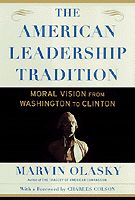 
The Persistence of Vision MICHAEL MCKINNEY 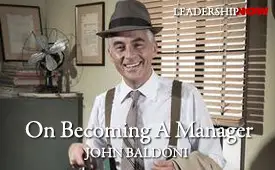
On Becoming A Manager JOHN BALDONI 
Communicating with Power: Putting Leadership on Parade KEVIN DALEY 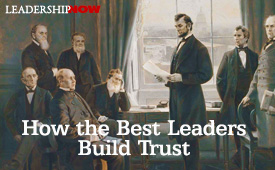
How the Best Leaders Build Trust STEPHEN M. R. COVEY 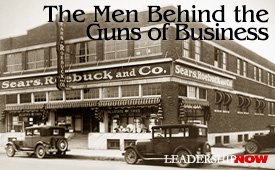
The Men Behind the Guns of Business RICHARD W. SEARS 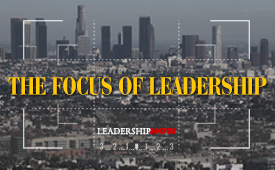
The Focus of Leadership MICHAEL MCKINNEY 
Why Leaders Fail MARK SANBORN |
 |
| ||
 | © 2019 LeadershipNow All materials contained in https://www.LeadershipNow.com are protected by copyright and trademark laws and may not be used for any purpose whatsoever other than private, non-commercial viewing purposes. Derivative works and other unauthorized copying or use of stills, video footage, text or graphics is expressly prohibited. |
||